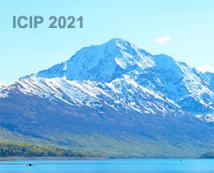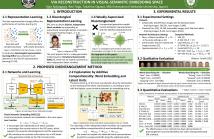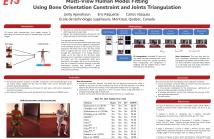
ICIP 2021 - The International Conference on Image Processing (ICIP), sponsored by the IEEE Signal Processing Society, is the premier forum for the presentation of technological advances and research results in the fields of theoretical, experimental, and applied image and video processing. ICIP has been held annually since 1994, brings together leading engineers and scientists in image and video processing from around the world. Visit website.
- Read more about Super-Resolved Imaging of Early-Stage Dynamics in The Immune Response
- Log in to post comments
The use of photo-activated fluorescent molecules to create long sequences of low-density, diffraction-limited images gives us the ability to achieve highly-precise molecule localizations. However, this methodology requires lengthy imaging times, resulting in poor temporal resolution. This is particularly problematic when dynamic interactions of live cells on short time scales are of interest. We consider the problem of shortening dramatically the acquisition times in super-resolution microscopy down to seconds, in order to image the cellular dynamics during T-cell activation.
- Categories:
 67 Views
67 Views

Energy resolved neutron imaging (ERNI) is an advanced neutron radiography technique capable of non-destructively extracting spatial isotopic information within a given material. Energy-dependent radiography image sequences can be created by utilizing neutron time-of-flight techniques. In combination with uniquely characteristic isotopic neutron crosssection spectra, isotopic areal densities can be determined on a per-pixel basis, thus resulting in a set of areal density images for each isotope present in the sample.
- Categories:
 21 Views
21 Views
- Read more about Deep Video Compression for Interframe Coding
- Log in to post comments
A typical learning-based video compression scheme consists of motion coding and residual coding. In this paper, our deep video compression features a motion predictor and a refinement networks for interframe coding. To save the bits for transmitting motion information, our scheme performs local motion prediction and sends only the differential motion vectors to the decoder. In the residual coding, we couple the residual decoder with the refine-net to reduce residual signal bits.
- Categories:
 76 Views
76 Views
- Read more about FEDERATED TRACE: A NODE SELECTION METHOD FOR MORE EFFICIENT FEDERATED LEARNING
- Log in to post comments
- Categories:
 30 Views
30 Views
- Read more about Interpretable representation learning on natural image datasets via reconstruction in visual-semantic embedding space
- Log in to post comments
Unsupervised learning of disentangled representations is a core task for discovering interpretable factors of variation in an image dataset. We propose a novel method that can learn disentangled representations with semantic explanations on natural image datasets. In our method, we guide the representation learning of a variational autoencoder (VAE) via reconstruction in a visual-semantic embedding (VSE) space to leverage the semantic information of image data and explain the learned latent representations in an unsupervised manner.
- Categories:
 70 Views
70 Views
- Read more about Weighted Average Precision: Adversarial Example Detection for Visual Perception of Autonomous Vehicles
- Log in to post comments
- Categories:
 12 Views
12 Views
- Read more about A DEEP LEARNING APPROACH FOR PREDICTION OF IVF IMPLANTATION OUTCOME FROM DAY 3 AND DAY 5 TIME-LAPSE HUMAN EMBRYO IMAGE SEQUENCES
- Log in to post comments
Various protocols have been developed to improve the success rate of In Vitro Fertilization (IVF). Earlier protocols were based on embryonic cell quality on embryos' third day. Newer protocols rely on the blastocyst quality (day-5 embryo).
Artificial intelligence (AI) systems for automatic human embryo quality assessment seem to be the natural trend towards improving IVF's outcome. AI systems can potentially reveal hidden relationships between embryos' various attributes. To this date, most AI systems assess single blastocyst images.
- Categories:
 20 Views
20 Views
- Read more about Multi-View Human Model Fitting Using Bone Orientation Constraint and Joints Triangulation
- Log in to post comments
We address 3D human pose and shape estimations from multi-view images. We use the SMPL body model, and regress the model parameters that best fit the shape and pose. To solve for the parameters, we first compute 3D joint positions from 2D joint estimations on images by using a linear algebraic triangulation. Then, we fit the 3D parametric body model to the 3D joints while imposing a bone orientation constraint between the 3D model and the corresponding body parts detected in the images.
- Categories:
 80 Views
80 Views
This work explores facial expression bias as a security vulnerability of face recognition systems. Despite the great performance achieved by state-of-the-art face recognition systems, the algorithms are still sensitive to a large range of covariates. We present a comprehensive analysis of how facial expression bias impacts the performance of face recognition technologies. Our study analyzes: i) facial expression biases in the most popular face recognition databases; and ii) the impact of facial expression in face recognition performances.
- Categories:
 26 Views
26 Views